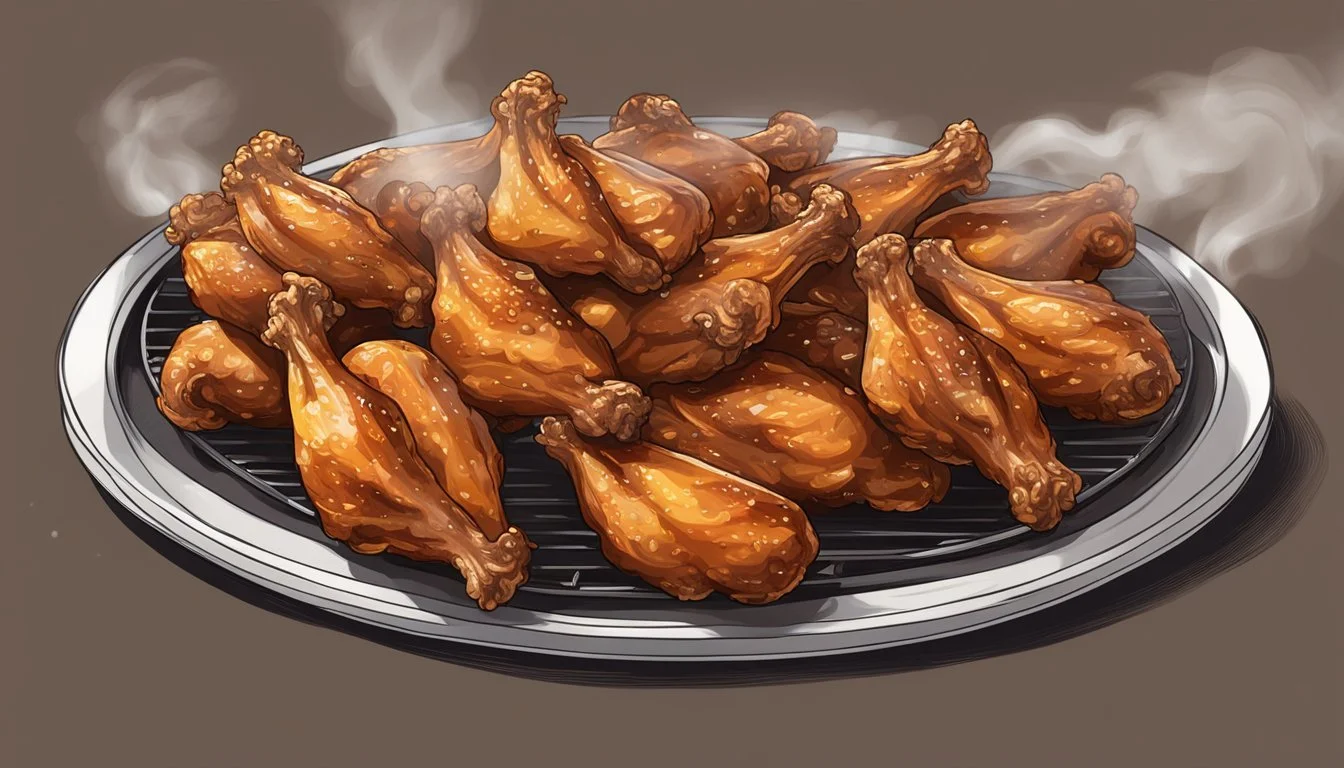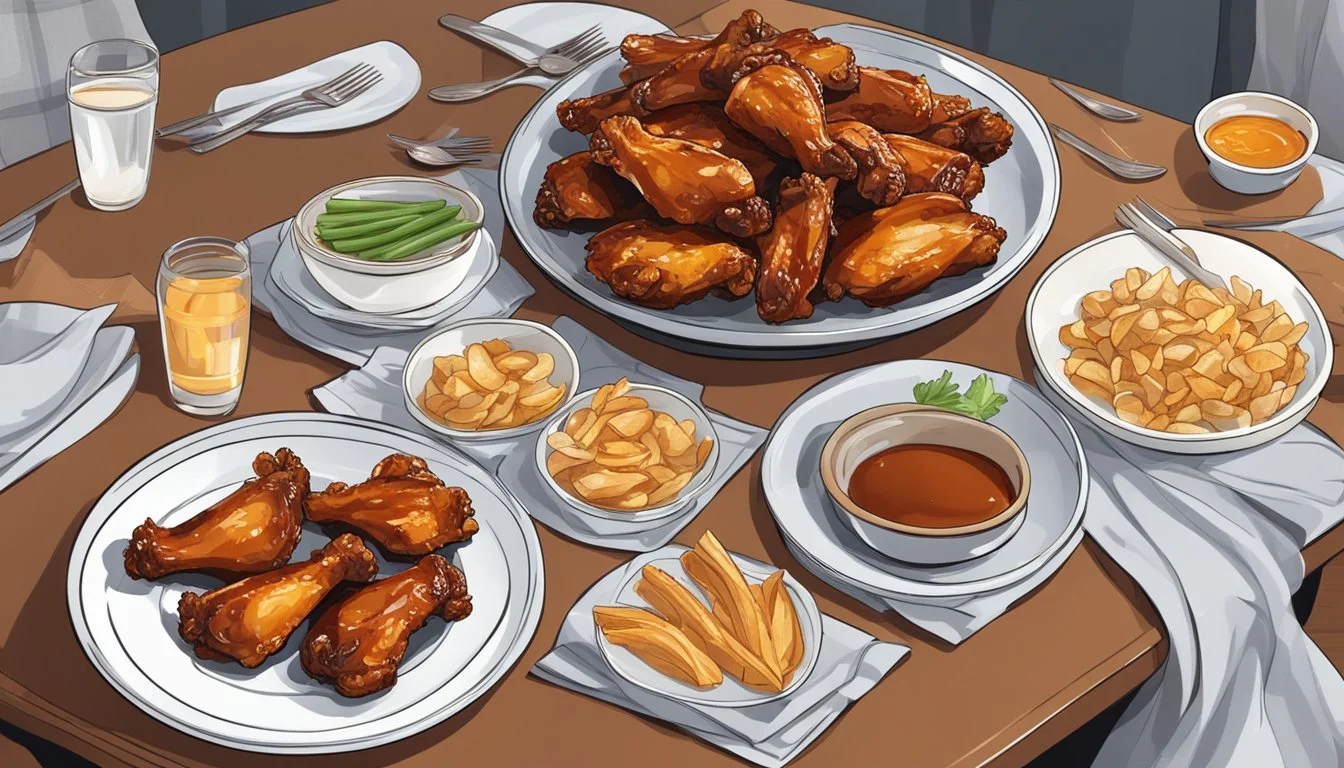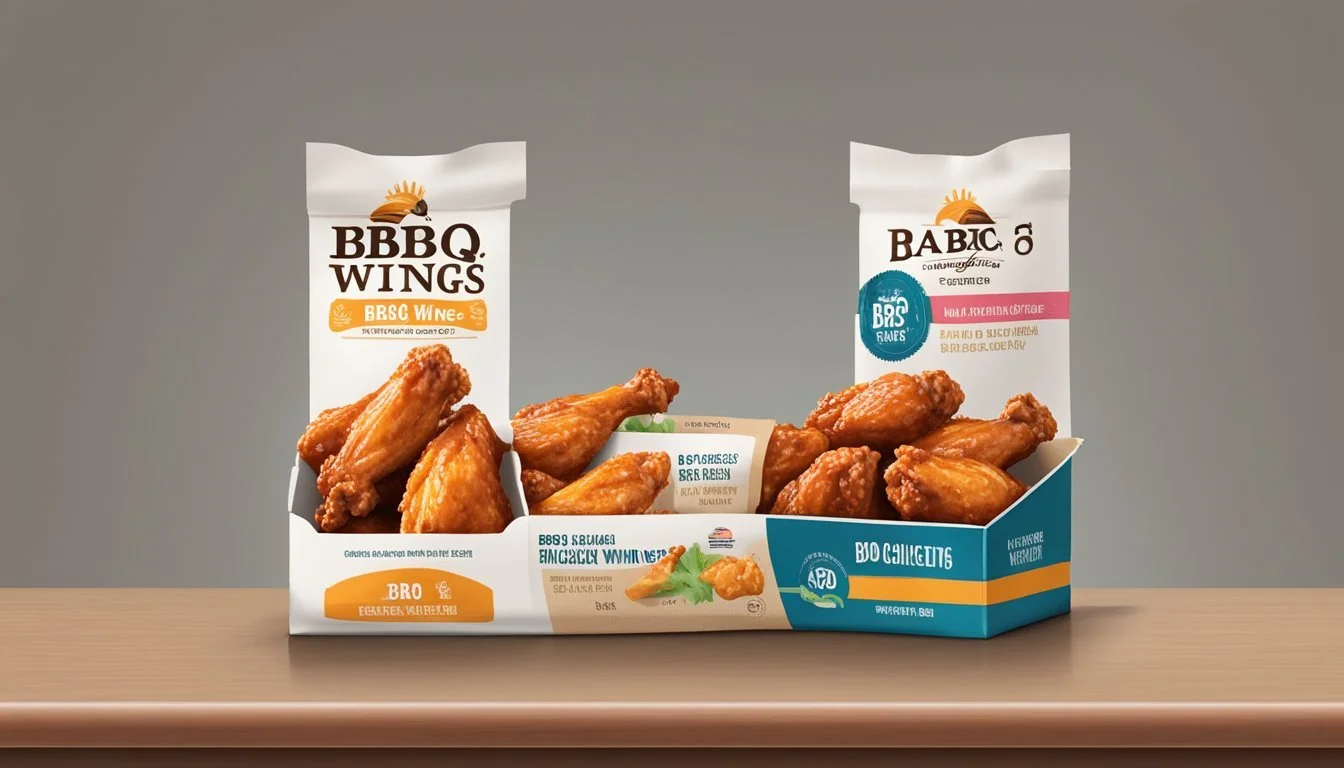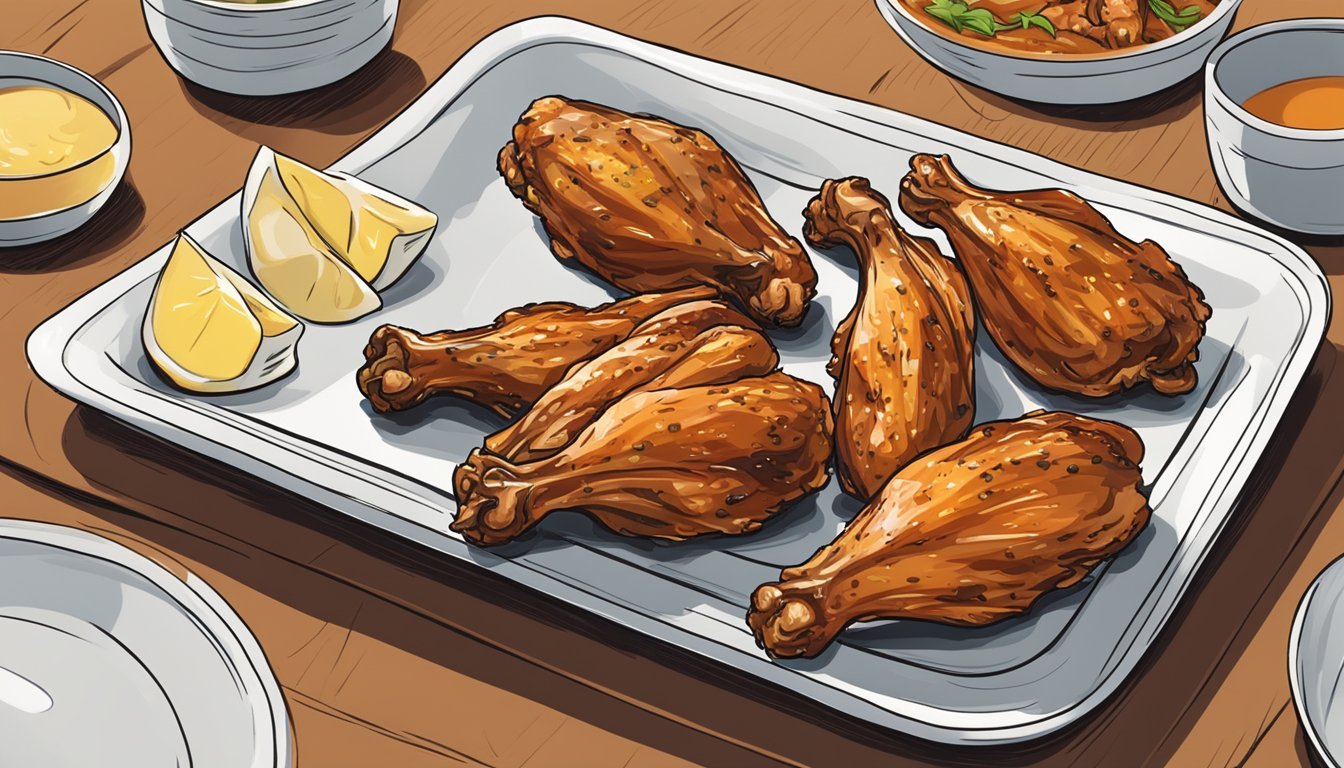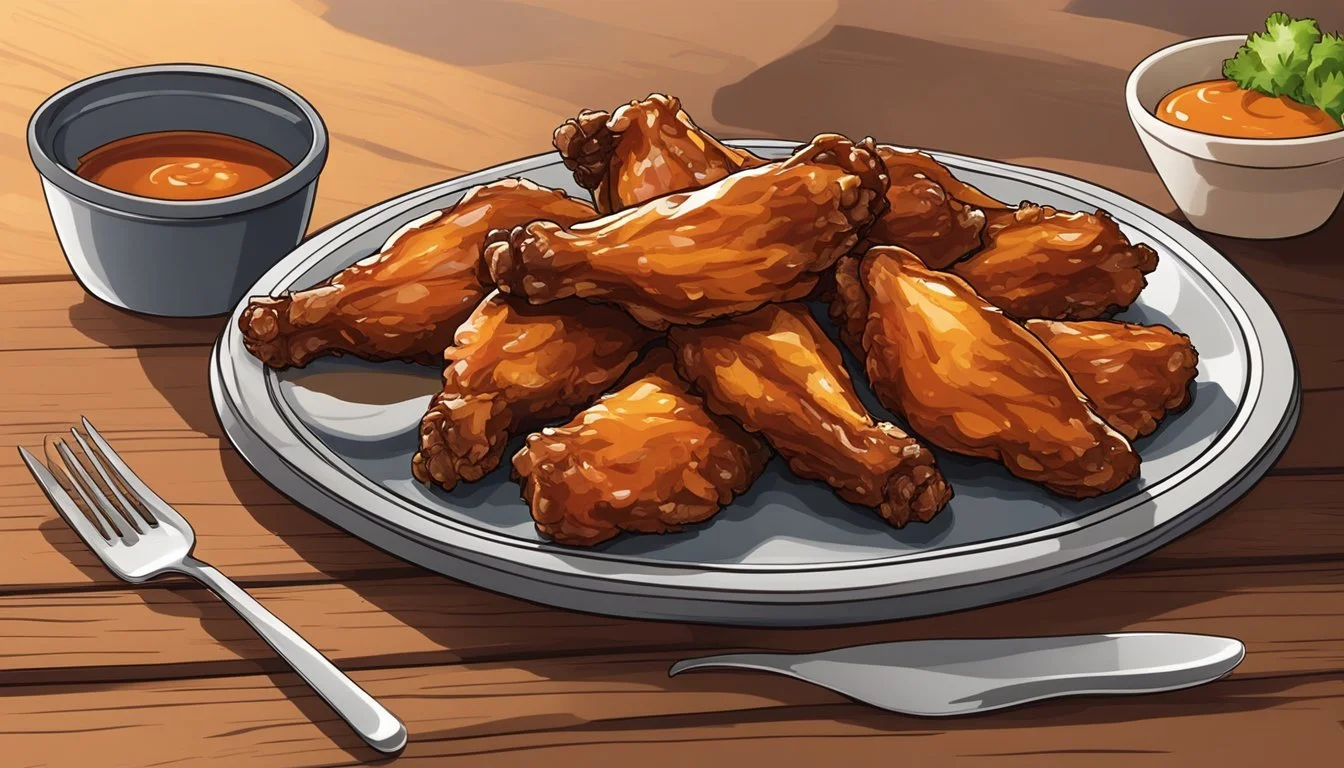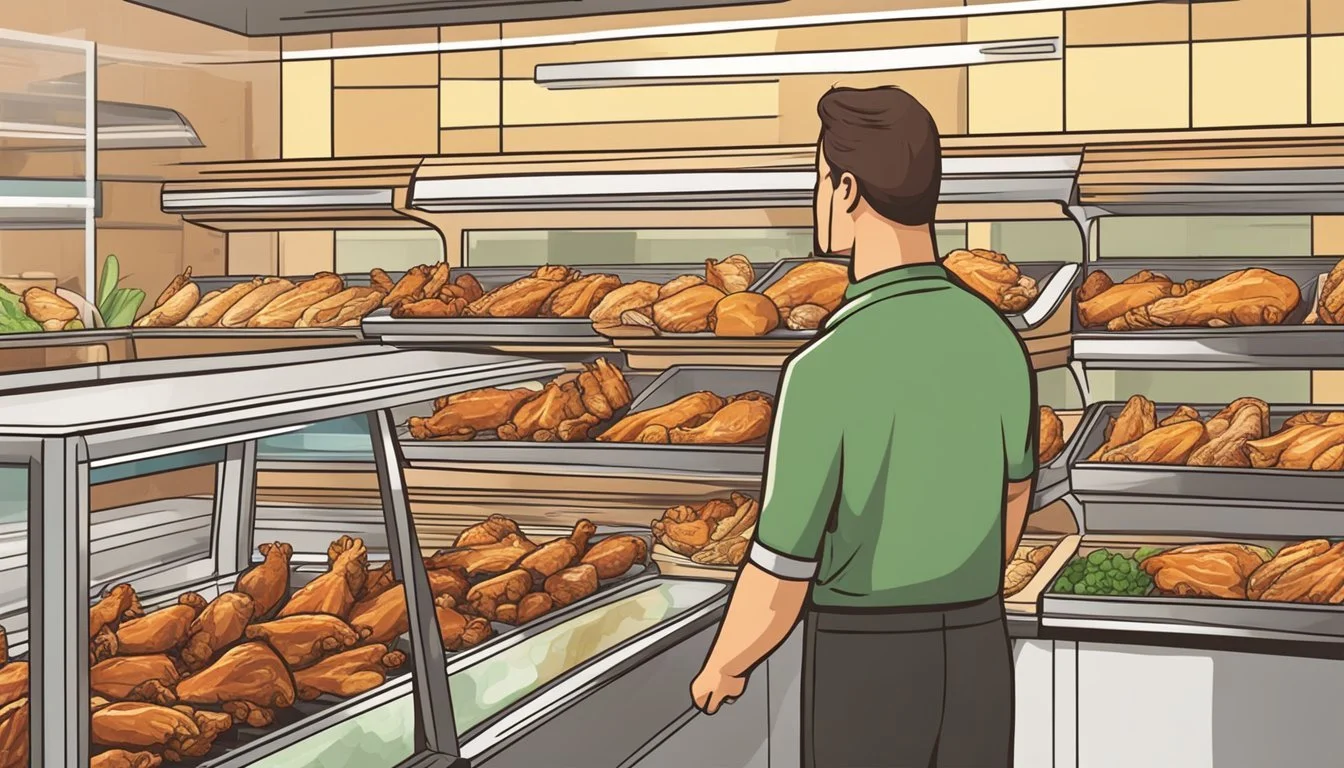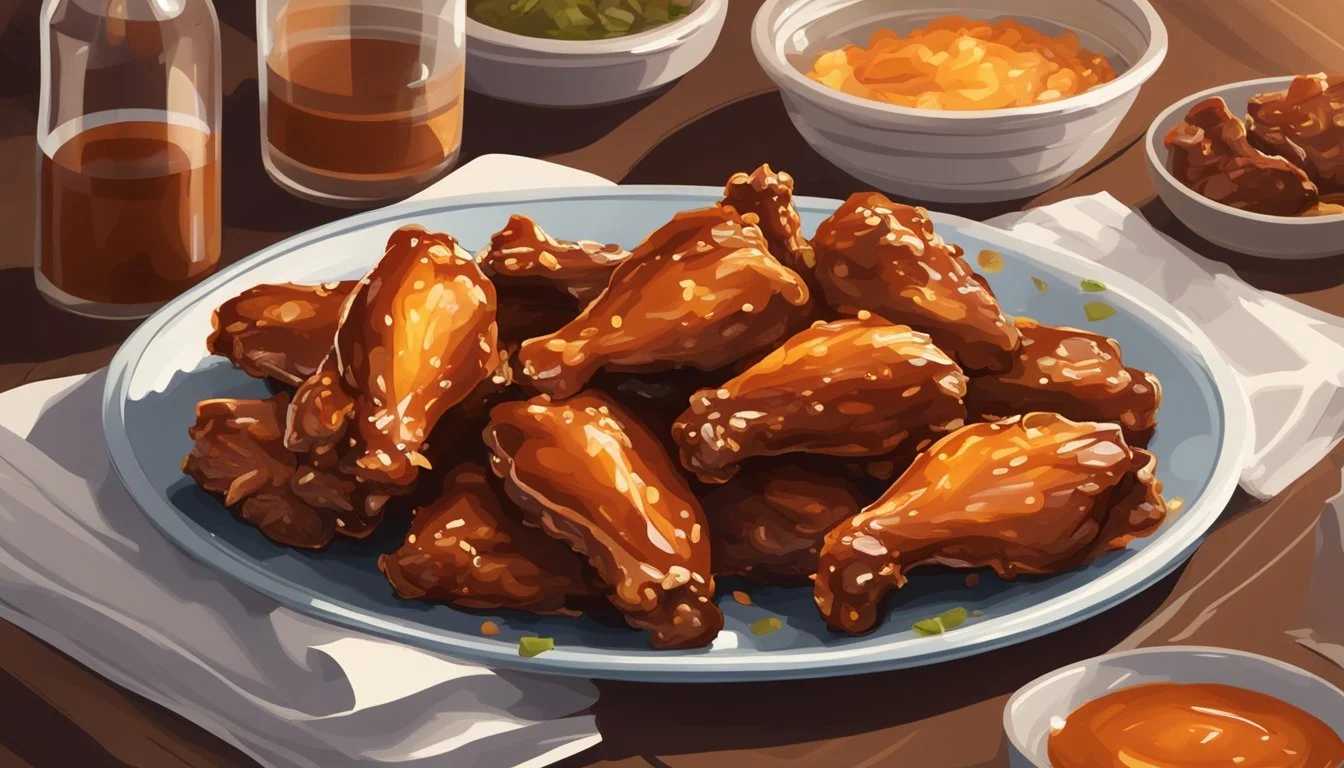How Long Do BBQ Chicken Wings Last?
Storage Tips and Safety Guidelines
BBQ chicken wings are a crowd favorite, whether for a casual backyard gathering or a game-day snack. Cooked BBQ chicken wings can last in the fridge for up to four days when stored properly. This makes it convenient to prepare them ahead of time and enjoy them throughout the week.
To ensure the chicken wings remain safe and tasty, it's essential to keep them refrigerated at a temperature below 40 degrees Fahrenheit. Storing your wings in an airtight container can further help maintain their freshness and flavor.
Reheating is straightforward; a brief 10-minute stint in a 400-degree oven should do the trick, or they can be enjoyed cold. With these simple storage tips, savoring your BBQ chicken wings at their best becomes easy and worry-free.
Understanding Chicken Wings
Chicken wings come from the wing section of the chicken. They are typically divided into three parts: the drumette, the flat (or wingette), and the tip.
Raw chicken wings are a popular choice for grilling because of their protein content and versatility. These wings need careful handling to avoid contamination.
Cooked chicken wings are a common barbecue favorite. When grilling, achieving the right balance of juiciness and crispiness is crucial. Grilled chicken wings should reach an internal temperature of 165°F (74°C) to ensure they are safe to eat.
Brining is a useful technique to keep the wings juicy. A salt-water solution helps maintain moisture during cooking. It's recommended to brine the wings for a couple of hours before grilling.
Selecting high-quality, uniform-sized wings is important. This ensures even cooking and better results. High-quality wings are typically fresh and free from added solutions, which can affect flavor and texture.
The protein content in chicken wings makes them a nutritious option, but the methods of preparation, like frying or grilling, can alter their healthiness. Grilling is often considered a healthier option compared to deep frying, as it uses less fat.
Storage Fundamentals
Properly storing BBQ chicken wings is essential to maintain their flavor and safety. Key considerations include refrigeration, freezing, and safe handling at room temperature.
Refrigeration
BBQ chicken wings should be stored in the refrigerator at a temperature between 33°F and 38°F (1°C to 3°C). Raw wings last up to 2 days, while cooked wings can remain fresh for 3-4 days. Using an airtight container is crucial to prevent contamination and moisture loss. Ensure the wings are covered completely to maintain their quality. Regularly monitor the fridge's temperature to keep the food safe and slow bacterial growth.
Freezing
For long-term storage, freezing BBQ chicken wings is an effective method. Wings can be frozen for up to 6 months. Before freezing, place the wings in airtight containers or heavy-duty freezer bags to prevent freezer burn. Label the containers with the date of storage to track their freshness. Maintaining the freezer temperature at or below 0°F (-18°C) ensures the wings remain safe to eat. When ready to use, thaw the wings in the refrigerator for best results.
At Room Temperature
It's critical to manage BBQ chicken wings carefully when they are at room temperature. Cooked wings should not be left out for more than 2 hours. If the ambient temperature is above 90°F (32°C), reduce this time to 1 hour. Beyond these time frames, bacterial growth accelerates, increasing the risk of foodborne illness. Keep wings covered with aluminum foil or plastic wrap if they must sit out temporarily, but prioritize refrigerating or freezing them promptly.
Shelf Life Details
BBQ chicken wings can have varying shelf lives depending on whether they are raw or cooked. Proper storage is essential for maintaining their freshness and safety.
Fresh Chicken Wings
Fresh chicken wings, when purchased from a grocery store, should be kept in the refrigerator immediately. Raw wings typically last up to 2 days at temperatures between 33 and 38 degrees Fahrenheit. Proper refrigeration helps in maintaining their quality and prevents bacterial growth.
To minimize contamination, it is recommended to store raw chicken wings in their original packaging or in an airtight container. If the wings emit an unusual odor or show any discoloration, it's best to discard them as these are signs of spoilage.
Cooked Chicken Wings
Cooked BBQ chicken wings generally last longer in the fridge compared to raw wings. When properly stored in airtight containers, they can remain fresh for 3-4 days at temperatures between 33 and 38 degrees Fahrenheit. The exact shelf life may vary depending on how fresh the chicken was before cooking.
Reheating cooked wings should be done to an internal temperature of 165°F to ensure safety. They can be reheated in a 400-degree oven for about 10 minutes. While cooked wings can be eaten cold, reheating them helps restore flavors and texture.
Proper storage practices ensure that cooked BBQ chicken wings remain enjoyable and safe for several days. Always inspect for any signs of spoilage before consumption, such as off smells or changes in texture and color.
Preventing Spoilage
To keep BBQ chicken wings fresh, proper storage is essential. Raw wings should be refrigerated at 33 to 38°F. This temperature range helps maintain freshness and inhibits bacterial growth.
Cooked wings can last 3-4 days in the fridge if stored correctly. Use airtight containers to prevent exposure to air and contaminants.
Signs of Spoilage:
Slimy texture: A slimy or sticky coating is a clear sign of bacteria breaking down the proteins.
Foul odor: Fresh wings have a mild smell. A sour or ammonia-like odor indicates spoilage.
Mold: Visible mold growth is a definite sign the wings should not be consumed.
Preventive Measures:
Temperature Control: Maintain a consistent fridge temperature.
Proper Packaging: Use airtight containers or vacuum-sealed bags.
Quick Storage: Refrigerate wings promptly after cooking.
Safety Tip: Always reheat wings to an internal temperature of 165°F (74°C) before eating to kill any harmful bacteria.
Checklist for Storage:
Airtight container
Refrigerate at 33-38°F
Reheat to 165°F before consuming
By following these guidelines, one can significantly reduce the risk of spoilage and enjoy safe, flavorful BBQ chicken wings.
Indicators of Quality
Assessing the quality of BBQ chicken wings involves observing several key aspects such as appearance, smell, and texture. These indicators help determine whether the wings are still safe to eat or if they have spoiled.
Visual Indicators
Examining the visual appearance of the wings is crucial. Fresh BBQ chicken wings should have a consistent color, typically a golden-brown hue.
If there is any discoloration, such as gray or green spots, this could indicate mold or spoilage. Mold growth can be another clear sign that the wings are no longer safe to consume.
Additionally, look for moisture loss; wings that appear dried out are likely past their prime.
Olfactory Indicators
Smell is another significant quality indicator. Fresh BBQ chicken wings should have a pleasant, smoky aroma.
A foul odor or sour smell is a strong sign of spoilage. Olfactory cues are often the first indicators that the wings are not fit for consumption.
When checking the wings, ensure you do so in a well-ventilated area to accurately detect any off-putting smells.
Texture Assessment
Texture plays a vital role in determining the freshness of BBQ chicken wings.
Fresh wings should feel firm to the touch and have a slight juiciness. Any slimy texture is an indication of bacterial growth, making the wings unsafe to eat.
Moisture loss can also affect texture, leaving the wings feeling dry and tough rather than succulent and tender.
Safe Preparation Methods
Proper preparation of BBQ chicken wings involves careful marinating and seasoning, followed by precise cooking techniques to ensure safety and quality.
Marinating & Seasoning
Marinating and seasoning chicken wings properly are essential for flavor enhancement and safety. A good marinade often includes salt, black pepper, garlic, and other herbs. These ingredients not only add taste but also help to tenderize the meat.
When marinating, the wings should be submerged in the mixture for at least 2 hours, but no more than 24 hours, and always kept refrigerated at 33-38 degrees Fahrenheit. This prevents bacterial growth while allowing the flavors to penetrate the meat. Seasoning the wings right before cooking is also crucial. A light dusting of salt, pepper, and other spices ensures a tasty exterior.
Tip: If using a dry rub, apply it evenly for consistent seasoning.
Cooking Techniques
Cooking chicken wings requires achieving the right internal temperature to ensure they are safe to eat. The wings should reach an internal temperature of 165 degrees Fahrenheit. Methods can vary, including baking, grilling, and smoking. Each method requires different attention to detail.
For baking, preheat the oven to 400 degrees Fahrenheit and cook for about 25-30 minutes. Grilling should occur over medium heat, turning the wings frequently to avoid burning, cooking for 20-25 minutes. Smoking is done at a lower temperature, around 225 degrees Fahrenheit, for 1-2 hours.
Consistency in temperature and cooking time ensures the wings are juicy and delicious without being undercooked.
Food Safety Considerations
BBQ chicken wings must be handled with care to prevent foodborne illnesses. Proper storage is essential to avoid any mishandling that could lead to bacteria growth.
Cross-contamination is a significant risk. Always use separate utensils and cutting boards for raw and cooked wings. This practice helps prevent the spread of harmful bacteria.
For raw wings, refrigeration is key. They can be kept in the fridge between 33 and 38 degrees Fahrenheit and should be used within 2 days. Plastic wrap or airtight containers help maintain freshness.
Cooked wings should be chilled shortly after cooking and kept in the fridge for up to 3-4 days. If they are left out for more than 2 hours, they should be discarded to minimize the risk of foodborne illnesses.
USDA guidelines recommend reheating leftovers to an internal temperature of 165°F to ensure all bacteria are killed. This precaution is particularly important for BBQ chicken wings.
By following these food safety practices, one can enjoy BBQ chicken wings while minimizing health risks.
Serving Recommendations
Proper serving of BBQ chicken wings involves both thawing and reheating to ensure they remain safe to eat and delicious. Implementing the correct methods will maintain their quality and flavor.
Appropriate Thawing
When thawing BBQ chicken wings, the safest method is to transfer them from the freezer to the refrigerator. This process should take around 24 hours. If time is a constraint, placing the sealed package in a bowl of cold water can speed up thawing.
Avoid using hot water at all costs, as this can promote bacterial growth. For a quicker method, the microwave can be used. Set it to defrost mode, ensuring to turn the wings frequently to thaw evenly. Be cautious, as microwaving might start cooking the wings, compromising the texture.
Correct Reheating
Reheating BBQ chicken wings properly is crucial to retain their texture and taste. The best option is to use an oven preheated to 350°F (175°C). Arrange the wings on a baking sheet in a single layer, and cover with foil.
Reheat for about 20-25 minutes or until they reach an internal temperature of 165°F (74°C). The microwave can also be used. Place the wings in a microwave-safe dish, cover, and heat on medium power in short intervals, checking often to avoid overcooking.
While the microwave is faster, it may make the wings less crispy. For the best result, the oven method is recommended.
Optimal Utilization
To make the most of your BBQ chicken wings, it’s crucial to properly store and creatively reuse leftovers. Explore various ideas and recipes to keep meals exciting while preventing food waste.
Leftover Ideas
Repurpose BBQ chicken wings in a variety of delicious meals to keep the family meals interesting. Shred leftover wings to create sandwiches or tacos. Adding them to salads can make a quick and hearty lunch.
For dinner, use the meat in an enchilada or casserole recipe. Pair shredded wings with homemade barbecue sauce to make a filling for stuffed bell peppers. For a simple snack or appetizer, serve the leftover wings with a side of honey mustard sauce.
Creating Sauces
Enhance the flavor of your BBQ chicken wings with a variety of sauces. Classic combinations like BBQ sauce can be easily made at home with ingredients like ketchup, brown sugar, and vinegar.
Experiment with spicy or tangy variations by adding hot sauce or mustard. For a sweeter alternative, a honey mustard sauce can be made with honey, mustard, and a touch of mayo. Customize your barbecue sauce with ingredients such as garlic, onions, or smoked paprika.
By making and matching these sauces with your wings, meals remain varied and flavorful.
Purchase and Selection
To maximize the shelf life and quality of BBQ chicken wings, it is crucial to carefully select fresh wings and store them under proper conditions. Whether buying from a grocery store or online, understanding the purchase and storage process is essential.
Buying Tips
When purchasing BBQ chicken wings, selecting fresh, high-quality wings is key. At the grocery store, check the sell-by date and ensure the wings are firm and free from any off-putting odors.
Signs of quality include:
Smooth and clear skin
No blemishes or bruises
Pinkish color, indicating freshness
Consider buying from reputable suppliers when shopping online. Look for customer reviews and product ratings to gauge freshness and quality. It's also beneficial to choose wings that are vacuum-sealed, which helps maintain freshness during transit.
Best Practices for Storage
Correct storage practices help extend the shelf life of BBQ chicken wings. Once purchased, keep the wings in their original packaging if unopened, and store them in the fridge at 33-38 degrees Fahrenheit.
For opened packaging, transfer the wings into an airtight container or wrap them tightly in plastic wrap to prevent them from drying out and absorbing other fridge odors.
Key storage guidelines:
Raw wings last up to 2 days in the fridge
Cooked wings can last for 3-4 days
By following these tips and practices, the quality and safety of BBQ chicken wings can be preserved for optimal enjoyment.
Enhancing Flavor & Texture
To elevate BBQ chicken wings, focus on perfecting both taste and mouthfeel. Proper seasoning and cooking techniques are essential for a delightful eating experience.
Flavor Enhancements
Marinades and spice rubs are vital for injecting flavor into chicken wings. A marinade might include ingredients like soy sauce, honey, garlic, and ginger. For a spicy twist, adding paprika, cayenne pepper, and black pepper can enhance the heat.
Dry rubs are another popular choice. Common elements include kosher salt, brown sugar, and a mix of spices such as cumin and chili powder. These combine to form a flavorful crust when the wings are grilled or baked.
Honey can be brushed on during the last 5 minutes of grilling to create a sweet, caramelized coating. This balances the savory spices and adds depth to the overall flavor profile.
Achieving Desired Texture
For crispy baked chicken wings, achieving the right texture is key. Coating the wings with a thin layer of baking powder before cooking can promote a crispy skin by raising the pH level and helping the proteins break down.
To keep wings tender, it's essential not to overcook them. Baking at 425°F for about 45 minutes usually strikes the right balance. Turning the wings halfway through ensures even cooking.
For extra crispy skin, letting the wings sit uncovered in the fridge for a few hours before cooking helps dry out the skin. This method is particularly useful for those who prefer crispy chicken wings.
By carefully managing these elements, one can significantly enhance the flavor and texture of BBQ chicken wings.
Serving as a Meal
BBQ chicken wings can be an excellent addition to any meal. When served as a main course, they are typically accompanied by various sides like coleslaw, cornbread, or baked beans.
For a family dinner, it's common to prepare a large batch of wings, ensuring there are enough for everyone. The recipe can be adjusted for spice levels to suit different tastes.
As an appetizer, chicken wings are frequently served at gatherings and parties. They are easy to eat and pair well with dipping sauces like ranch or blue cheese.
A well-rounded meal with BBQ chicken wings can be both satisfying and nutritious. Including a mix of vegetables, grains, and protein ensures a balanced diet.
For instance, a plate could include:
Chicken Wings: 5-6 wings per person
Side Options: Coleslaw, cornbread, baked beans
Beverage: Iced tea or lemonade
When presenting the meal, ensure everything is served hot and fresh. Arrange the wings neatly on a large platter, and place sides in smaller bowls around the main dish.
Using a good quality BBQ sauce that complements the wings enhances the flavor and overall dining experience. For added variety, consider offering a few different sauce options.
Final Thoughts on BBQ Chicken Wings
BBQ chicken wings are a beloved dish for many, celebrated for their golden, crispy exterior and juicy interior. Whether grilled, smoked, or oven-baked, achieving and maintaining freshness is key to their quality.
Smoked chicken wings can offer a unique flavor profile, but they require careful attention to cooking times and temperatures. They typically need about 3 hours at 225°F to become tender and full of smoky goodness.
For those who prefer grilling, chicken wings should be cooked for about 20-30 minutes, depending on the heat and size of the wings. Ensuring an internal temperature of at least 165°F is essential for food safety.
Storing BBQ chicken wings properly is vital for maintaining their quality. After cooking, they should be refrigerated within 2 hours and can be kept in the fridge for 3-4 days. For longer storage, freezing the wings is an option, extending their usability for up to 4 months.
Reheating leftover wings can help preserve their golden crispness and juicy taste. Utilizing an oven or air fryer typically yields the best results, avoiding the sogginess that can occur with microwave reheating.
Proper attention to simple preparation methods and storage techniques ensures BBQ chicken wings remain fresh and delicious for any occasion.

